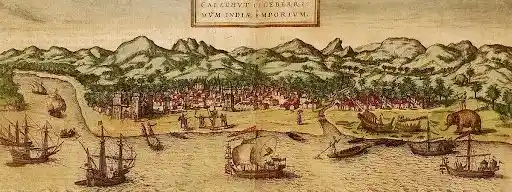The Battle of Calicut
The year 1599 was coming to an end. The Zamorin had had enough. He couldn't handle the growing power and the ever-spreading interference of the Marakkars in his kingdom. Scared of losing his prominence in his own kingdom and to remove the Marakkar pawn from the game, the desperate Zamorin approached his nemeses. The Portuguese. And what better opportunity for the Portuguese to achieve their one true dream of monopolising the Indian Ocean?

Battle of Calicut. Image Source: Wikipedia
The Zamorin and the Portuguese shook hands, conspiring against a common enemy. The Marakkars had no clue as to what was happening behind their backs. Fifty years of a sustained relationship between the Zamorin and the Marakkars was about to undergo a major event that was going to change the course of history and the fate of the Marakkar community.
Kunjali Marakkar IV was the head of the community at that time. During one of his expeditions, he came across a Chinese slave, Chinali, who was coerced to work under the Portuguese. He took Chinali with him, freeing him from the bondage of the Portuguese and soon became fond of him. Chinali helped him in the upcoming expeditions and gained the stature of one of the most feared lieutenants of the Marakkars. Chinali made sure to gain victory in any looting that took place against the Portuguese, terrorising his former masters and letting them know who dominated the sea-fearing regions.
The Portuguese had had enough. A plan was initiated and schemes were brewed. After days of planning and plotting against the Marakkars, the Portuguese and the Zamorin were ready. Andre Furtado de Mendonca, the captain and governor of the Portuguese, led an army to attack the fort of the Marakkars. Chinali and the forces of the Marakkars were trapped inside their fort. With depleting resources, Kunjali Marakkar IV had to make a decision soon. He knew that he was completely tied up and that the only possible way to save the lives of numerous families within the fort and protect the children and women was to surrender.
He went to negotiate the terms of his surrender with the Zamorin and Mendonca—leave the children and the women, and Marakkar IV would only surrender in front of his mentor, the Zamorin. Initially, Mendonca agreed to his wishes and let everyone go. However, he never had the intention of taking Marakkar IV to the Zamorin. He betrayed him and took him to Goa with 40 other prisoners. He was hanged, and later, his severed head was sent to Cannanore to send a message to any other chieftain or merchant that ever tried to gain such power or authority.
The year 1599 came to an end and so did the Marakkar Dynasty.


